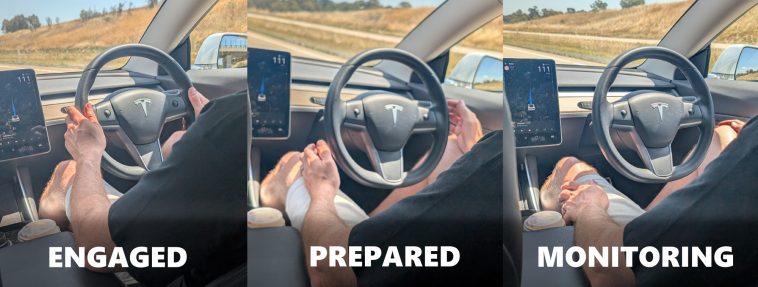Over the past few days, I’ve driven more than 1,000 km on a road trip from Wodonga to Canberra and back.
Since receiving Tesla’s latest Software Update – 2024.44.25.4, I’ve been sharing videos of its performance in areas like Vision Autopark, Smart Summon and more.
This trip to Canberra provided a great opportunity to test the performance of Navigate on Autopilot.
Navigate on Autopilot
This feature requires the software upgrade ‘Enhanced Autopilot’ which currently costs A$5,000 or the ‘Full Self Driving Capability’ package that costs A$10,100.
When you enable this option, you’ll be notified the feature is in Beta and you’re still responsible for the vehicle etc.
Personally I want to experience the best Tesla has to offer, so my settings are:
Enable at Start of Every Trip: Disabled
Speed Based Lane Changes: Mad Max
Exit Passing Lane: Enabled
Require Lane Change Confirmation: Disabled
Lane Change Notification: Vibrate
Once enabled, your experience of driving on the freeway/highway changes dramatically.
Autosteer from basic Autopilot already keeps you centered in the lane lines and Traffic-Aware Cruise Control already slowed you to the vehicles ahead, while Tesla’s computer vision is monitoring speed signs for changing speed zones and adapting accordingly.
Navigate on Autopilot (NoA) takes this to the next level by overtaking slower vehicles, ensuring you arrive at the optimal time. NoA will also take merge you on to and off the freeway/highway (divided roads).
The 3 driving modes of NoA
I really have 3 driving modes, Engaged, Prepared, Monitoring.
Engaged In this mode, I’m fully engaged, usually highway entrance/exit, adjacent trucks encroaching on my lane, stopped vehicles on the shoulder, roadworks etc.
Prepared This is slightly more relaxed, but still ready to intervene, this occurs on locations or stretches of road I don’t feel completely comfortable in the car’s ability to respond to. This is usually for short periods of time.
Monitoring In this mode, I’m very confident in the car’s ability to manage the situation. There’s clearly marked double white lines to indicate lanes, I look ahead and see there’s no debris on the road, or any traffic situations that could cause grief.
In this mode I’m still addressing the nag on a regular basis (still max 45s), paired with driver monitoring, my eyes are on the road, ready to re-engage at any time.
Typically in this mode, I’ll settle in to have my right hand providing constant torque to the wheel to avoid the nag and the drive kind of just happens. The indicator comes on to go around the car ahead and then back again once clear, it’s like magic when it works (which thankfully is most of the time), but it’s not without challenges.
Benefits
I find NoA to be amazingly helpful on a long drive, allowing you to relax, enjoy the surrounds a little more, while monitoring the car and being ready to take over in the event it falters.
When you get out of a drive, you’re so much fresher than manual driving and I also find the automatic overtakes with NoA, make the drive even less stressful.
Obviously I’d prefer these instances to be zero, as making it rock solid would allow you to relax further.
Issues
Above we describe the magic that is NoA, and for 95% of my drive, that’s what I get to experience, but the system is not without it’s flows, even on our latest Australian build, 2024.44.25.4.
NoA still suffers from random lane changes ‘to follow route’ despite it having dozens of KM to go and often with no traffic around, it changes lanes when it doesn’t need to.
Between the trip there and the way back, this would have easily happened a dozen times. With low traffic, I let the system do what it wanted for the most part, only intervening a couple of times, in an effort to avoid the cars behind starting to ask questions or be concerned at my strange behaviour.
Let’s put some more numbers around this.
The trip each way is 700km (plus around 50km of Canberra roads that also supported NoA). Of the 750km of road, I estimate 95% of it was on NoA, so ~712.5km and a dozen unnecessary lane changes means on average I had one every 59.38kms.
On the surface, having to experience (and potentially override) a dozen unnecessary lane changes, is annoying, but given you’re traveling almost 60km between instances, this means the system is providing massive value for the majority of the time, but does require monitoring.
The unnecessary lane changes are annoying, and if they bug you enough, you can enable require confirmation before lane change to be in control of when your car moves.
I’ll continue to try each build and share my experiences.
Critical Disengagement
I did experience 1 critical disengagement today on the way home. I was on NoA, traveling in the right lane, I had passed a car on the left, clear of it, but had not yet been moved out of the ‘fast lane’.
I was passing a turning lane, often short and used for people to turn around.
The car decided it’d try to move me into the right most lane, as if I was on a 3-lane highway.
Despite doing 110km/hr, I had plenty of time to intervene, and this is precisely why I monitor the system and react, because I know it’s not flawless.
The latest in the America
As we reach the end of 2024, Tesla’s AI team continue to roll out new software releases and the very latest to roll is 2024.45.25.10 which includes FSD (Supervised) V12.6.x.
This build is particularly important as it supports the latest V12.6.x build on older Tesla’s made with HW3 (found in my car and many Aussie Tesla’s).
From what we see in videos shared online from the US and Canada, V12.6.x is a significant update and the kinds of issues with NoA appear to be non-existent.
While the Tesla AI team are clearly working very hard on solving one of the most complex challenges (autonomy), that doesn’t make it any easier for Australian consumers who are still to waiting to get their hands on FSD.
While we’re yet to see a RHD market get access to the technology, the performance of the LHD model is really encouraging and appears to be a significant safety improvement.
While NoA is a really great feature I enjoy using, FSD (Supervised) can’t come soon enough to Australia (and other regions of the world).
Pulled in a few important improvements from v13 into this 12.6 release for AI3. Initially rolling out to S/X customers, other platforms should be within a week.
— Ashok Elluswamy (@aelluswamy) December 31, 2024
If you enjoy my Articles, please consider using my referral link to purchase a Tesla –https://www.tesla.com/referral/jason45054 – A$1,400 off – US$2,000 off





GIPHY App Key not set. Please check settings